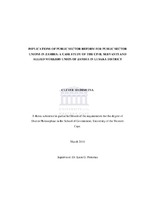| dc.description.abstract | The thesis examines the implications of Public Sector Reform (PSR) for public sector unions in Zambia. Using the case study strategy, the research investigates the Civil Servants and Allied Workers Union of Zambia (CSAWUZ) in Lusaka district under the rubric of PSR. The research is qualitative in nature. Two types of data were collected, namely, secondary and primary data. A sample of 25 key informants was engaged in the research. These informants include five managers of public institutions and 20 leaders of the CSAWUZ. The methods of multistage, purposive and snowball sampling were used to select the informants. Secondary data were collected by reading documents on PSR and trade unions while primary data were collected by conducting semi-structured interviews with the sampled informants. The data are analysed using the method of content analysis. The findings reveal that Zambia is characterised by a young, unskilled and impoverished population. The government faces challenges to deliver services especially in rural areas and to the female population. There are three major categories of government institutions in Zambia. These are central government, local government and parastatals. There are also different types of trade unions organising employees in these institutions. They include sectoral unions, enterprise unions, occupational unions, industrial unions, and federations of trade unions. However, the operations of these unions have been challenged by the reform of the public sector. Two generations of PSR have been implemented in Zambia. These are New Public Management (NPM) and post-NPM reforms. On the one hand, NPM reforms emphasised the effectiveness of market forces and the weakness of government regulation. On the other hand, post-NPM reforms emphasise the interconnectedness of stakeholders in the processes of policy formulation and implementation. These stakeholders include government, business, civil society organisations, employers and trade unions. The implementation of PSR is influenced by the interplay of a number of factors. These include the recognition of problems in the public sector, the emergence of a new ideology, and the presence of actors spearheading the reform of the public sector. The findings show that PSR involves changing the role of the public sector in the process of providing goods and services. Instead of the public sector being the only provider, it is a partner. As a partner, its role is to create an environment that encourages the growth of the private sector. However, this kind of reform negatively affects trade unions in the public sector. The effects include reductions in union membership, income and power. Although public sector unions are negatively affected by PSR, they have agency and do not just wait to become victims of the reform process. They make strategies to adapt to the changing circumstances. These strategies include diversifying the membership, servicing the membership, decentralising the organisational structure of the union, coordinating union activities, and forming alliances with external organisations dealing with issues affecting workers. This implies that trade unions in the public sector have opportunities to deal with challenges facing them under the rubric of PSR. | en_US |

